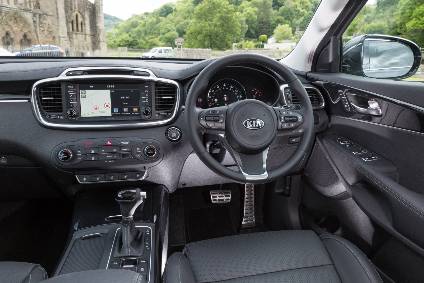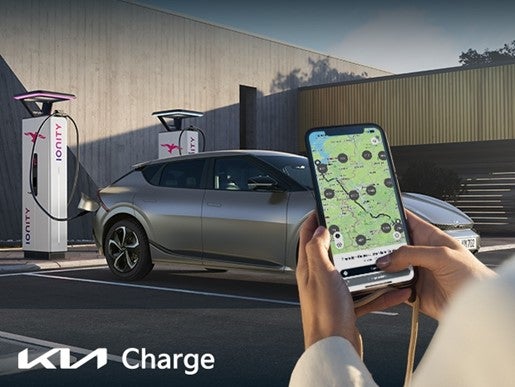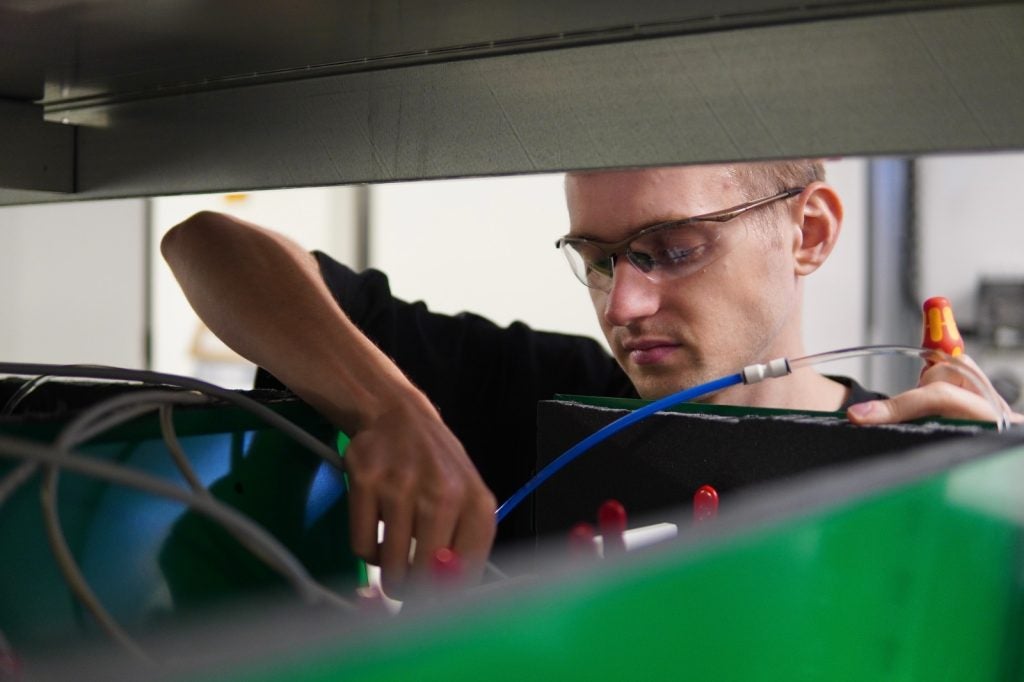
When Kia launched its third-generation seven-seater Sorento in 2015, it coincided with the second phase of the carmaker's coming of age; shifting it from a purely value-driven company into a world-class manufacturer of premium-quality cars. A recent face-lift saw new instrumentation, active safety features and an eight-speed automatic transmission. Sounds good but does it really put Kia on a par with Audi? Continuing QUBE/just-auto's review of interior design and technology trends, we take a look inside the latest incarnation to see how it has transformed the brand.
The market for SUVs is, of course, very different today to 2002 when the Sorento first appeared in car showrooms. The people who drove 4x4s, as SUVs were still referred to in those days, were mostly those who actually needed them to get from A to B or for heavy-duty towing. With this in mind, most 4x4s were built with a body on top of a rugged separate chassis.
By the time the second-gen Sorento was launched in 2009, the marketplace had changed. There had been a huge surge in demand for fashionable SUVs (sometimes used as status symbols for the school run, dubbed 'Chelsea Tractors'), but many of the new devotees wanted the driving qualities they were used to in premium saloons. So SUVs, with only a few exceptions, adopted a monocoque, all-in-one body construction.
Fast-forward to 2015, when the latest generation Sorento emerged, the market had changed again. So what was carried forward by customer demand, and what did people ask Kia to change? A spokesman said: "Previous Sorento buyers told us not to change the essential characteristics of the styling or reduce the space, towing performance, value for money and warranty, so we have at least maintained and in most cases improved those things. What they did want to see made better was the steering and fuel economy. The latest car shows we have listened and acted upon their requests."
Harman supplies the sound system.
In ascending order, the current Sorento model line-up is KX-1, KX-2, GT-Line, KX-3 and GT-Line S. All have seven seats with a 40/20/40 split in the middle row and a 50/50 split in the rear. Comfort-wise, our KX-3 featured heated steering wheel, front and outer rear seats. It also features dual automatic climate control, a panoramic sunroof, powered front seats, alloy pedals, an engine start/stop button and smart entry system, a smart powered tailgate, a ten-speaker harman/kardon sound system and a wireless phone charger located in a cubby just ahead of the gear stick. Err, anything else? Sorento certainly has plenty of kit to keep the driver and occupants entertained via an eight-inch touchscreen infotainment system with sat-nav, connected services, Apple CarPlay and Android Auto, enabling smartphone integration.
The plush cabin is cloaked in soft black leather to make you feel instantly comfortable. The switches and buttons dotted across the centre stack have been grouped according to function and ergonomics. In other words, they are exactly where you expect to find them. The instrument cluster itself features white-on-black graphics which provide all the usual information. In higher trim levels, namely the KX-3, GT-Line and GT-Line S, this is replaced by a seven-inch TFT display which can be customised via steering wheel-mounted controls.
How well do you really know your competitors?
Access the most comprehensive Company Profiles on the market, powered by GlobalData. Save hours of research. Gain competitive edge.

Thank you!
Your download email will arrive shortly
Not ready to buy yet? Download a free sample
We are confident about the unique quality of our Company Profiles. However, we want you to make the most beneficial decision for your business, so we offer a free sample that you can download by submitting the below form
By GlobalDataSeating
The throne-like driver seating position that SUV buyers crave is both comfortable and supportive on long journeys. Space in the rear is also generous, thanks to the panoramic roof flooding the cabin with natural light. The second-row seats slide forward by 270mm, giving access to the two seats in the rear. The transmission tunnel has been eliminated, whereas in the previous model it was 64mm tall, so there is now a completely flat floor for passengers' feet, and the mid row of seats is split 40/20/40. The second-row seat remote folding mechanisms are operated from within the boot, enabling these seats to collapse in just a few seconds. The third-row seats can flip down by pulling on a belt tie.
Another neat feature on the KX-3 – and becoming popular on competing models – is the power liftgate. When the owner is within one metre of the rear of the car and has the car key on them, the liftgate opens automatically after three seconds. The liftgate can also be set to raise to different heights convenient for the owner. While other models allow you to open the boot by waving your foot under the bumper, the Sorento's 'smart power tailgate' moves the game on a little.
Storage
If you are looking for some nitty-gritty data, the boot is a little longer (87mm to be precise) than the previous model (third-row seats folded) which, along with the increase in wheelbase, enlarges carrying capacity. The lift-over height of the rear sill was also lowered by 5mm. The Sorento can, therefore, carry 142 litres of luggage when all seats are in use, 605 litres with the third-row seats folded (+17.5 per cent) and 1,662 litres when travelling as a two-seater. This is up to 90 litres more than the previous model.
Cabin storage includes cupholders in the centre console and rear armrest, centre console storage box, illuminated glovebox, front and rear door storage and front seatback pockets. There is also a range of power sockets to keep the occupants charged up and connected.
Advanced driver assistance systems
Sorento is available with Kia's so-called DRiVE WISE Advanced Driver Assistance Systems (ADAS). For example, the new Driver Attention Warning system combats distracted or drowsy driving. The system monitors a number of inputs from the vehicle and the driver. It sounds a warning chime and displays a graphic in the instrument binnacle if it senses a lapse in concentration from the driver.
The Sorento includes lots of other acronym-happy safety kit, including Adaptive Smart Cruise Control, Blind Spot Detection (BSD), Rear Cross Traffic Alert (RCTA), Lane Keep Assist System (LKAS), 360-degree Around View Monitor, and Speed Limit Information Function (SLIF). The latter displays the maximum speed permitted on any particular road in both the instrument cluster and the navigation screen. Another feature recognises speed limit reduction – for example, due to roadworks or smart motorway gantries – a camera ensures the correct limit is displayed.
Rear visibility inside SUVs is rarely good yet the Sorento's parking sensors help in that department. There is also a surround view monitor available on the top-drawer GT-Line S. This uses front and rear cameras, plus two more mounted in the door mirrors, to give the driver a bird's eye view of the Sorento at speeds up to 12.5mph, making parking and manoeuvring in difficult spaces a breeze.
On the road
The KX-3 that we took out for a spin last week was filled with luxuries. It is also very quiet thanks to liberal use of sound absorption and insulation materials. For example, there are insulating pads in the dashboard, transmission tunnel and around the front wheel arch and wing areas. Even the dashboard has a 29 per cent thicker soundproofing panel.
All versions are powered by a 197bhp 2.2-litre turbodiesel engine able to drive all four wheels through an intelligent four-wheel-drive system. Designed in-house by Kia and launched in 2016, the transmission has no fewer than 143 newly-patented technologies. Compared to other automatic transmissions, the carmaker points out that its unit requires fewer control valves, enabling a more direct mechanical link to the engine. This allows the transmission to shift more quickly than the outgoing six-speed automatic. The greater choice of gears enables more decisive acceleration while reducing CO2 emissions from 172 to 159 g/km.
Magna Powertrain supplies the electronically controlled all-wheel-drive system.
Magna Powertrain supplies the electronically controlled all-wheel-drive system, known as Dynamax. It continuously monitors driving conditions and anticipates when the all-wheel drive will be required, whereas other systems react only to changing conditions. It is paired with something called an Advanced Traction Cornering Control (ATCC). Compared with all-wheel-drive systems which control wheelspin by braking a spinning wheel or reducing engine torque, ATCC automatically and instantaneously transfers torque to those wheels which still have grip, even before the electronic stability control system intervenes. This is linked with hill-start assist control which prevents roll-back when setting off uphill.
While Kia's strapline is 'The Power to Surprise', we weren't all that shocked to find a generous list of standard equipment on the KX-3. To be fair, we have come to expect that from this carmaker over the past few years. We were surprised, however, to discover the third-row seats to be quite comfy, complete with a climate control panel on one side.
On balance, the interior of the Sorento is spacious and well thought through with plenty of luxuries to justify the price. The car's fuel economy lived up to expectations, too. Fully loaded up with student fresher clobber, the diesel engine delivered enough oomph when needed. While the headlined combined fuel economy is 46.3 mpg, our spin covering motorways, country roads and crawling town traffic came close to that average. Putting classy German premium manufacturers to one side, the Sorento cabin has moved the Korean brand on from days of old. Its rivals include the Nissan X-Trail, Ford S-Max and Hyundai Santa Fe.





